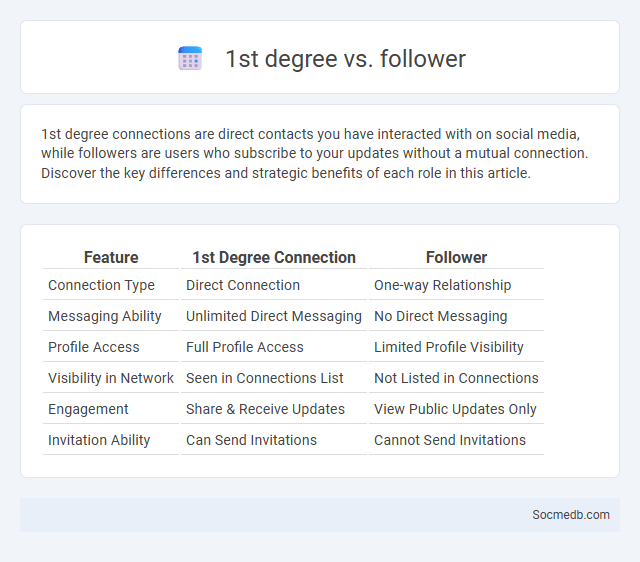
Photo illustration: 1st degree vs follower
1st degree connections are direct contacts you have interacted with on social media, while followers are users who subscribe to your updates without a mutual connection. Discover the key differences and strategic benefits of each role in this article.
Table of Comparison
| Feature | 1st Degree Connection | Follower |
|---|---|---|
| Connection Type | Direct Connection | One-way Relationship |
| Messaging Ability | Unlimited Direct Messaging | No Direct Messaging |
| Profile Access | Full Profile Access | Limited Profile Visibility |
| Visibility in Network | Seen in Connections List | Not Listed in Connections |
| Engagement | Share & Receive Updates | View Public Updates Only |
| Invitation Ability | Can Send Invitations | Cannot Send Invitations |
Understanding Connection Degrees on Social Networks
Understanding connection degrees on social networks reveals how individuals are linked through direct and indirect relationships, typically categorized as first, second, and third-degree connections. First-degree connections are direct contacts, while second and third-degree represent friends of friends, expanding the reach and influence within the network. Analyzing these connection degrees helps optimize communication strategies, influence marketing, and network growth by leveraging the layered structure of social interactions.
What is a 1st Degree Connection?
A 1st Degree Connection on social media represents a direct link between You and another user, allowing immediate interaction such as messaging and content sharing. This connection level is crucial for networking, providing a trusted circle of contacts that can help grow your professional or social reach. Understanding and leveraging Your 1st Degree Connections can enhance engagement, foster collaboration, and open doors to new opportunities.
The Role of Followers in Online Platforms
Followers on social media platforms significantly influence content visibility and engagement rates, acting as a bridge between creators and wider audiences. Your follower count impacts algorithmic prioritization, enhancing reach, while active followers contribute to authentic interactions and brand credibility. Building a loyal follower base fosters community growth and amplifies your online presence.
Defining 2nd and 3rd Degree Connections
Second-degree connections on social media are individuals connected through a mutual first-degree contact, expanding networking opportunities beyond direct relationships. Third-degree connections extend one step further, linking users through two intermediaries, which broadens reach within professional or social networks. Understanding these connection degrees enhances targeted communication and strategic relationship building on platforms like LinkedIn.
1st Degree vs Follower: Key Differences
Your social media network's strength depends on distinguishing between 1st-degree connections and followers. 1st-degree connections involve mutual relationships allowing direct messaging, fostering stronger engagement and trust, while followers are one-way relationships primarily consuming your content without direct interaction. Recognizing this difference enables targeted communication strategies to maximize influence and community-building efforts.
Network Growth: Leveraging Connection Degrees
Network growth on social media thrives by strategically leveraging connection degrees, which measure the direct and indirect links between users. Expanding first-degree connections increases immediate reach, while fostering second and third-degree contacts amplifies content visibility across broader audiences. Analyzing connection patterns and engagement metrics enables targeted outreach that accelerates follower acquisition and strengthens community influence.
Benefits of Expanding Beyond 1st Degree Connections
Expanding beyond first-degree connections on social media increases visibility, enabling access to diverse networks and potential opportunities for collaboration, recruitment, and market expansion. Engaging with second and third-degree contacts enhances knowledge sharing and fosters professional growth by exposing users to varied perspectives and industries. Leveraging these extended connections boosts brand awareness and drives targeted traffic, facilitating more meaningful and strategic relationship building.
Strategies to Convert Followers to 1st Degree Connections
Personalized engagement through direct messaging and tailored content significantly increases the likelihood of converting social media followers into 1st degree connections. Utilizing platform-specific features such as LinkedIn's connection requests with personalized notes or Instagram's story polls encourages meaningful interaction and trust building. Consistent value-driven communication, including sharing industry insights and responding promptly to comments, fosters deeper relationships that transform passive followers into active network contacts.
Privacy and Access: Connection Level Implications
Social media platforms collect vast amounts of user data, raising significant privacy concerns related to data sharing and unauthorized access. Connection levels between users influence exposure risks, as closer network ties can lead to increased visibility of personal information. Implementing robust privacy settings and access controls is essential to mitigate potential breaches and protect user confidentiality.
Maximizing Opportunities via Connection Degrees
Maximizing opportunities on social media hinges on leveraging first, second, and third-degree connections to expand reach and influence. Engaging with second-degree contacts through mutual connections can amplify content visibility exponentially, increasing the chances of collaboration and business growth. Harnessing the power of network algorithms to strategically connect with relevant audiences drives meaningful interactions and maximizes social capital.
 socmedb.com
socmedb.com